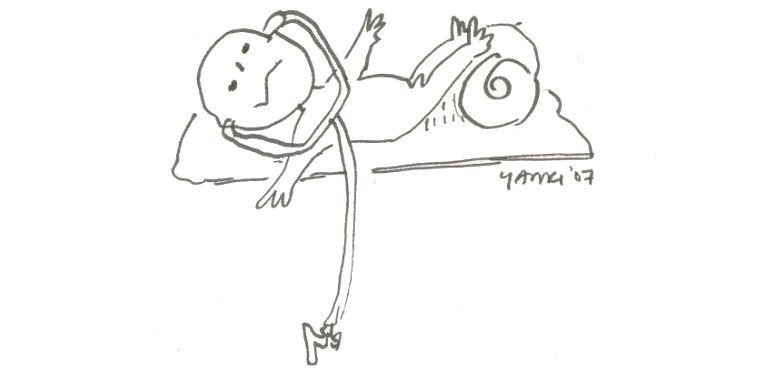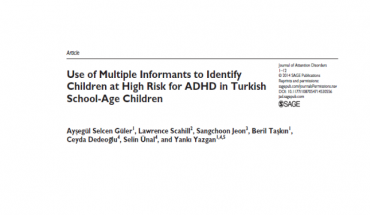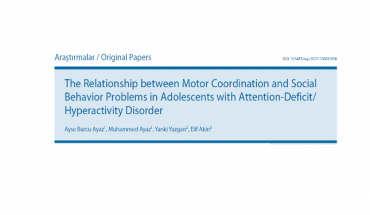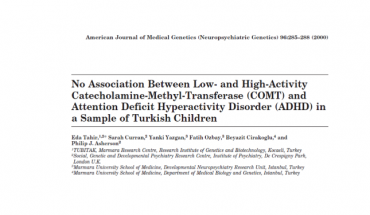Commentary on: “CHILD PSYCHIATRIC DIAGNOSIS AND CLASSIFICATION: CONCEPTS, FINDINGS, CHALLENGES & POTENTIAL” by Sir Michael Rutter
Mothers may be among the best diagnosticians of developmental and behavioral problems in young children. If not for the positive predictive power of the mother’s diagnostic ability, few kids would make it to the child and adolescent psychiatrist (“help-seeking”) unless they really get into trouble. Mothers can sense that there is something wrong associated with a burden (“impairment”) despite their being naive in the sense of medical diagnostic algorithms, while we, as doctors, with more reflective and systematic-analytic approach, need to focus on what number, duration and composition of symptoms would lead to a diagnosis (“DSM, ICD”).
This distinction of naivite and reflectiveness in diagnostic “styles” is close to what Friedrich Schiller made between naive poets who write spontaneously and non selfconsciously, and sentimental poets who are reflective and questioning about how and what they write (Pamuk, 2010). Orhan Pamuk, establishing the focus of his Harvard lectures on the application of this distinction to novel writing (and inspiring the title of this commentary) notes that the German sentimentälische has a closer meaning to “reflective” or “pensive.”
Professor Rutter’s article is so thought provoking, , and so cogent that it is both tempting and impossible to disagree with his points. Each paragraph of Rutter’s article deserving in-depth discussion,I will restrict this commentary to impairment, help-seeking and prognosis as parts of diagnosis, and a few points about trichotillomania and ADHD.
Primary Care
A separate classification for primary care, as suggested in Professor Rutter’s article, is definitely an important need in the field of child and adolescent mental health, where there are several layers and levels of services, provided by medical and nonmedical disciplines that are differentially sensitive to the diagnosable conditions. A prototype approach, somewhat naively utilized can already be found in nonmedical mental health professionals’ approach and is useful for purposes of screening and referral. This is what parents may also be doing when they read a newspaper article about autism, find identical symptoms with their child, and seek help. A whole constellation of symptoms are reduced to “one good reason” (of course, can be two or three, but not many) at the “screening” and “referral” based primary care systems where the “real” diagnosis and treatment is provided by the psychiatrist at an “higher grade” of care. This fast and frugal approach may be necessary for the primary care level.
The fast and frugal “one good reason” approach, that may fit well with primary care level diagnostic needs, is based on “looking up factors in order of importance, stopping the search if a factor allows it, and classifying the object according to this factor” (Gigenzerer, 2007). That process can take place either in an emergency room setting (which patient with a chest pain should go the intensive care unit?) or at a school (who should see the child and adolescent psychiatrist?), at any place where more serious or complex cases should be triaged to receive “higher” services. The primary care professional, the parents or the patient present the “case” to the next level to learn whether there is a diagnosis associated with the condition so that it should receive clinical attention.This is different from the comprehensive (“sentimental”) diagnostic process at a higher level of care. .
Prototypes
A prototype-screening diagnosis carries the hard-to-avoid risk of being rounded up to a “real” diagnosiss, i.e. overdiagnosis of the condition as requiring clinical attention. For example, in school settings, diagnostic and treatment referrals take place via two main routes. If a prototype diagnosis of attention deficit-hyperactivity disorder (ADHD) is established upon scoring above the cutoff on a symptom checklist, the possibility of a diagnosis of ADHD is present, and a consequent referral takes place.
In a more naive context, where no symptom checklists are available, an underachieving or disruptive child who is first classified only as “impaired” may be referred for a CAP consultation for determining the condition associated with the observed impairment. In the first case of symptom-based referral, diagnosis would be the result of a reflective, “sentimental” search for an explanation behind the observed phenomena (e.g., symptoms displayed, a dysfunction). In the second case, where a more pragmatic, or naive in Pamuk-Schillerian sense, approach is taken, the goal at the primary care level is limited to a search for alleviation of the harm associated with a presumed dysfunction. Symptoms reflecting the dysfunction might be documented usually after the impairment, i.e., when harm, is seen, although they might have been present without being noticed before the impairment.
Is impairment necessary for diagnosis?
This brings us to another important discussion in Professor Rutter’s article, that is whether to remove impairment from being a requirement for making a diagnosis. While what is happening and why are most meaningful to professionals, our patients and their families are interested about what will happen to them (and how soon), and whether an intervention is warranted. The degree of temporal discounting by the parents of the future impairment (the consequence) influences whether the condition will be presented to the attention of a clinician for a treatment consideration.
The requirement of pervasiveness of ADHD symptoms as indicated by observations and information obtained cross multiple settings (at school and at home) and multiple informants (parents and teachers, and self) is another way of making rigorous diagnoses. When a disagreement between the informants, and the discordance between settings is present in symptom detection, using OR and AND combinations lead to prevalence estimates ranging from 2.5-to-17.4 %. Adding the impairment criteria narrowed this range to 0.64-6.9 % (Güler et al., 2010). To avoid overdiagnosis of a condition, utilization of impairment as part of the diagnostic procedure appears to be an imperfect but a better way.
Visibility, help-seeking behavior and impairment
As in Professor Rutter’s example of “atherom plaque (causing no impairment, yy) demonstrated by catheterization”, a condition does not need to be validated by the impairment it causes; however, the condition is medically acknowledged only when it is diagnosed. For a condition to reach the “status” of a diagnosis, being seen, or being noticed is a must. A condition is less likely to receive a diagnosis unless it is brought to the attention of a professional due to its impairment. We may use a broader definition of impairment as burden or “cost” resulting from avoidance, accomodation and compensation associated with the condition, not only distress and disability. Thus, diabetes under control, bringing the burden of use of insulin and restrictive diet, still causes an impairment contrary to Professor Rutter’s example. Lack of impairment is hard to achieve, once when a diagnosis is present.
Why would the individuals and families present to a clinician if there is no impairment? Help-seeking behavior is elicited by the changes in the child’s or his/her environment that are impairing and are related to the symptoms. Impairment brings the patient to the doctor after becoming visible, and may be associated with any form of burden or cost. Professor Rutter asks, while discussing the age of onset criterion, whether a neurodevelopment disorder (ADHD) involving small head size and cognitive impairment can truly have no manifestations until adolescence. Smaller head size and lower cognitive reserve should have necessitated a referral or help seeking behavior before adolescence, were it present in each case of ADHD. However, there are many cases with higher IQ and possibly bigger heads who still match the symptom count criteria, but are not (yet) impaired owing to the compensatory effects of “protective” constitutional and environmental factors.
Professor Rutter’s suggestion that trichotillomania is of limited clinical importance and “perhaps should be dropped” is disaggreeable. Trichotillomania, with an estimated lifetime prevalence of 1-3% is associated with significant impairment and a number of treatments are available (Bloch & Kratochvil, 2009).
Even symptoms in the absence of a diagnosis “fit” to appear in the prevalence rates can still cause impairment enough to seek for help. The presence of anxiety/depression and of obsessions was associated with help-seeking without mental disorders. (Fullana et al, 2009).
Reading Professor Rutter’s article led me to reconsider the question that how and why we should be involved in the diagnostic process. My medical school notes remind me that “for the clinician as opposed to the investigator, there is an imperative in attending to the relief of the stress” (Eisenberg, 1977). This imperative is somewhat similar to what lies behind the mother’s naive approach in making an early diagnosis of developmental delay with little understanding of the diagnostic algorithms. Clinicians, different from mothers or healers, have access to other resources to reconcile their sentimental and naive diagnostic approaches. Pamuk’s description of being a novelist fits well to being a diagnostician, which “is the art of being both naïve and sentimental at the same time,” and “finding the equilibrium between the naïve and sentimental within”.
References
-Bloch, M., & Kratochvil, C.J. (2009). Trichotillomania across the life span. Journal of the American Academy of Child Adolescent Psychiatry, 48, 879-883.
-Eisenberg, L. (1977). Psychiatry and Society. The New England Journal of Medicine, 296, 903-910.
-Fullana M.A., Mataix-Cols, D., Caspi, A., Harrington, B.A., Grisham, J.R., Moffitt, T.E., & Poulton R. (2009). Obsessions and compulsions in the community: prevalence, interference, help-seeking, developmental stability, and co-occurring psychiatric conditions. American Journal of Psychiatry, 166, 329-336.
-Gigenzerer, G. (2007). Gut Feelings (pp.134-157). London: Penguin Books.
-Glascoe, F. P. (2000). Evidence-based approach to developmental and behavioural surveillance using parents’ concerns. Child: Care, Health and Development, 26, 137-149.
-Guler A., Scahill L., Jeon S., Taskin B., Dedeoglu C., Ünal S., & Yazgan Y. (2010) .Identification of children at high risk for ADHD in a school sample in Turkey. The Scientific Proceedings of the 2010 Annual Meeting of the American Academy of Child and Adolescent Psychiatry, p. 259.
-Pamuk, O. (2010). “What our minds do when we read novels.” (pp.1-31), In: The naive and the sentimental novelist. Harvard University Press.




